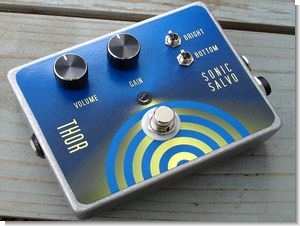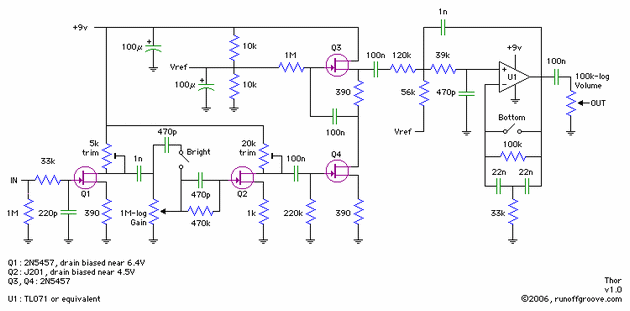
Circuit 2n5457, j201 fet and tl071 opamp based on the pcb drawing and there is a list of materials. You must use a 9 volt battery to feed the circuit. You cannot get quality sound with different power sources. It already consumes very little power. A quality alkaline 9v battery runs the circuit for a long time.
This project is rated 3 out of 3 for its level of complexity. Launched in March 2004, the Thunderchief project was the first runoffgroove.com circuit to be developed using the tube-to-FETs process. Inspired and enlightened by Doug Hammond’s brilliant Meteor circuit, we used the same approach to capture some of Marshall Super Leader’s legendary magic. We were pleased with the performance of the track, but there were problems.
The first problem was the Phase Converter phase. Many builders have had difficulty adjusting the bias voltage to the recommended value for that stage. Even those who can adjust the discharge voltage have sometimes reported that their builds sound different from the clip we posted. This stage needed to be cured or eliminated without affecting the target sound.
Another area of dissatisfaction was the lack of tone controls. We’ve published the full tonal stack version of Thunderchief in our FAQ, but few have found it. We decided that a significant improvement to the circuit should include some kind of tone control. Instead of simply adding the usual passive three-button tone stack, we developed an active second-order high-pass filter combined with deep bass boost.
The third item we wanted to address was a sound generating circuit that was more representative of the vacuum tubes in the amp. During the development of the second generation Fetzer Valve, we found that the Law of Three Half can be used to produce a more accurate harmonic content than with a triode tube.
Finally, we wanted to fix the amount of gain available in the circuit. Using the process of converting from tubes to FETs, Thunderchief and many other distortion circuits often have too much gain to accurately emulate the sound of amps. We realized that in order to make the new circuit as authentic as possible, we needed to tame this overly distorted sound.
We’ve given the new circuit an apt name for its booming voices: Thor.
Our primary inspiration was once again the Marshall SuperLeader. Numerous old Marshall tracks and diagrams were scanned for the precise components that make up the vowel sound. After trying many, but not all, of these adjustments, we arrived at the values shown above.
The smaller Bright limit on the volume control is taken from JTM and early Super Leads. This value provides a usable Bright setting without the harsh treble effect exhibited by later amps. Beginning in 1969, amps often had 5000pF caps, which were almost always removed or replaced with a much smaller value.
The classic 470k/470pF filter before the second gain stage was chosen for its fuller sound. This is a later Super Bullet filter with a lower refractive frequency than the older design giving a fuller sound.
The Mu-amp section better simulates the single-order harmonics of the amplifier’s Class AB push-pull distortion. For those without a 4×12 cabinet, the added Sub control closely mimics the bass resonance of the famous Marshall speaker arrangement. All these components give it a sound similar to the classic Marshall amp and correct the shortcomings of the aging Thunderchief.
Circuit diagram

Test music
source runoffgroove.com Guitar Distortion Circuit schematic PCB files alternative link:
Şifre-Pass: 320volt.com
Published: 2010/01/06 Tags: audio control circuits
PIC16F877 LM35DZ Graphic LCD Temperature Meter Proton ide
New project based on PIC16F877 lm35dz temperature sensor and receive information we display on lcd graphics … LM35DZ temperature sensor-55C to +150 C temperature ölçebilir.lm35dz 10mV per degree of temperature sensor generates energy. 1C = 10mV = 1V voltage while the 100C is üretir.lm35 analog temperature sensor.